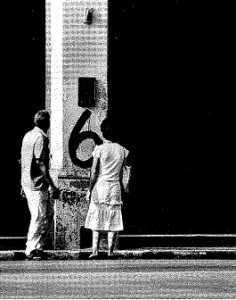Potential Ideological Implications of Tourism + Forms of Contestation
February 23, 2012 by admin
The 1992 Constitution of the Republic of Cuba states, “Socialist state property…is the property of the entire people” (Article 15). It then continues by defining “state property” as all land that does not belong to small farmers or collectives, including all social, cultural, and labor-related spaces. Therefore, the physical fabric of Cuba, particularly its urban morphology, belongs ideologically to the Cuban people.
Also during the 1990s, Cuba experienced its “special period” after the collapse of the Soviet Union, its main trading partner. This period was marked by a marked decrease in the flow of capital into the country and subsequent changes to state policy in an effort to ameliorate the financial situation. In particular, tourism was allowed to increase dramatically and “tourist enclaves” were created on segregated beach towns as well as the major cities. This presents a series of problematic ideological ruptures.
David Harvey, the New York University geography professor who serves as a major Marxist proponent of “the Right to the City, ” writes, “The question of what kind of city we want cannot be divorced from that of what kind of social ties, relationship to nature, lifestyles, technologies and aesthetic values we desire. The right to the city is far more than the individual liberty to access urban resources: it is a right to change ourselves by changing the city. It is, moreover, a common rather than an individual right since this transformation inevitably depends upon the exercise of a collective power to reshape the processes of urbanization. The freedom to make and remake our cities and ourselves is, I want to argue, one of the most precious yet most neglected of our human rights.”
In capitalist societies (Harvey utilizes 19th century Paris–– Walter Benjamin’s “Capital of Modernity”–– as his example), urbanization constitutes a prominent strategy for the expenditure of surplus capital and labor. Cities are built and rebuilt through projects of various scale, often to create new spaces for consumption and thus to generate more capital. This process initiates profound alienation of urban inhabitants from the places they once intimately knew. In many countries, particularly since the advent of the neoliberal economy, these projects have taken the form of massive tourist development.
Urbanization projects undertaken for the sake of tourism constitute a unique form of this alienation. Large sums of capital are employed to erect luxurious facilities that are not available to the local population. Additionally, these facilities are designed in a way to satisfy the image of the place desired by the tourist. Simultaneously, the areas of a city designated most “authentic” to a particular cultural image receive the largest amount of capital from the state for their preservation. The city becomes a series of façades, maintained for the visual consumption of the tourist. Likewise, Harvey notes that these processes of urbanization effectively encompass all physical space through “phenomena ranging from agribusiness to second homes and rural tourism.”
Thus, in Cuba, these developments possess major ideological implications, perhaps which are more dramatic as a result of its Marxist aspirations. As Joseph Scarpaci and Amanda Portela articulate, the choices of which places represent the patrimonial “heritage” becomes has political implications as it renders the Cuban culture into an image. Racial and misogynistic stereotypes are often applied to satisfy the expectations of foreigners. Additionally, Cubans have expressed outrage at this form of “tourist apartheid” and the economically stratifying effects of the introduction of the Cuban convertible dollar. Perhaps most importantly, the collective ownership of property in Cuba is partially negated by private enterprise and its uneven distribution of capital among the Cuban populace.
Therefore, with the essential commodification and objectification of the Cuban physical landscape, graffiti and public art takes on political implications. In the 1980s, before the onslaught of mass tourism, many Cuban artists and artist collectives staged public performances that were loaded with sociopolitical critique. This incited contestations between artists and the state. Similar practices were again revived in the 1990s, in particular with the street artist Carlos Garaicoa. He began to clandestinely paint the numbers 6 and 39 around Havana. These altered the experience of the urban environment by instigating the creation of narrative explanations and a multiplicity of understandings. In the process, they provoked a re-consideration of the urban form and its inhabitant’s relationship with it.
Simultaneously, Cuban artists began to experience an inflow of foreign capital in the 1990’s. As Sujathata Fernandez explains, these “new market conditions for production” were created with the passing of a bill in 1993 that allowed for artists to be paid in convertible dollars. However, this came with the implicit condition that the work would not contain the same degree of criticism that was contained in the work of the 1980s. Towards the end of the decade there was an increase in public artist collectives that tended towards work that investigated the subjective experience in relation to the political.
In, The Structural Transformation of the Public Sphere: An Inquiry into a Category of Bourgeois Society, Jurgen Habermas expounds the importance of physical public spaces (the coffeehouse) for the creation of the public sphere (within 19th century bourgeois society) as a necessity for transformative political discourse. As the ideology of the Cuban government becomes threatened by its allowance of tourism, contestation may arise along the very borders of this foreign incursion. The public sphere of the country may be articulated through the long-standing tradition of public art: an attempt to utilize a physical articulation of an abstraction to defend that same abstraction.
Cuban constitution: http://www.cubanet.org/ref/dis/const_92_e.htm
David Harvey, “The Right to the City.” International Journal of Urban and Regional Research 27.4 (2003): 939-41. Print.
Leave a Reply
You must be logged in to post a comment.
